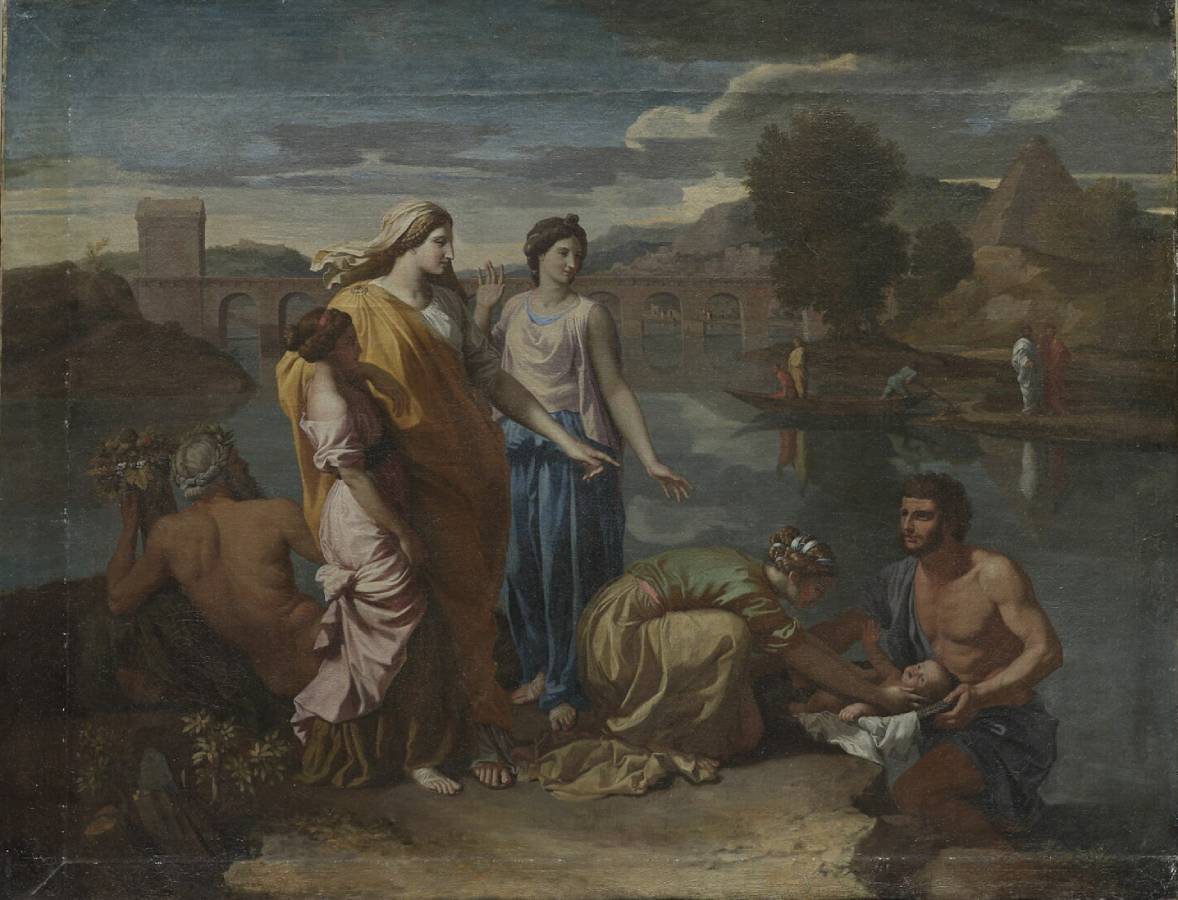Poussin, Nicolas (1594-1665)
Moïse sauvé des eaux (Moses saved from the waters)
c.1638
Oil on canvas, 94 x 121 cm
Musée du Louvre, Paris
Featuring one of Nicolas Poussin‘s favorite subjects, this painting was very popular in the 17th century. It inspired the Saved Moses by Sébastien Bourdon kept at the National Gallery of Art in Washington, and probably also that of Thomas Blanchet which entered the Louvre Museum in 1985, two works dating from the 1650s. Modern criticism has been more reserved. Denis Mahon mentions in particular the very cold color and some weaknesses. However, it reveals parts of great delicacy, which cannot be by the hand of a copyist (cf. Mahon, 1965). Poussin painted Pharaoh’s daughter inspired by an ancient bas-relief now kept in the British Museum in London, Bacchus visiting the poet Icarius: the princess is standing, taller than the others, dressed in a long ocher dress held by a precious stone on the shoulder, ordering to rescue the newborn. But Poussin‘s main visual source is an engraving after the Saved Moses painted in the decor of Raphael‘s Lodges in the Vatican. These were one of the main visual references for biblical subjects in the seventeenth century. Poussin was perhaps inspired by the engraving by Sisto Badalocchio because it is the only one, prior to 1638, which was executed as a counterpart, just like the painting in the Louvre (cf. Milovanovic, 2015a). Poussin borrowed from Raphaël the group of figures gathered on the shore around Moses as a child. All eyes are on the newborn, expressing surprise, admiration and concern. Like Raphaël, Poussin ordered the group in two concentric arcs: the first formed by a young woman squatting, her hands outstretched; the second by the standing figures looking at the child. The servant who dived into the water to bring back the basket is quoted in the Jewish Antiquities of Flavius Josephus, undoubtedly one of the textual sources of the composition (cf. Verdi, 1995). Exegesis identifies Moses and Christ, who were both exposed at birth: Moses to fortune subject to Providence, Christ for the salvation of men; Moses in a basket, Christ in a stable; Moses in the waters of a river, Christ at the bend of a public road; Moses adopted and nourished by Egypt, Christ adored by the Gentiles represented by the Magi. Moses had been exposed in the river by his mother, who thus hoped to save him, for Pharaoh had ordered that all the Jewish firstborn in Egypt be put to death; likewise, Christ had to flee to Egypt because Herod had ordered the massacre of all the children of Bethlehem under the age of two. We do not know who commissioned the painting, but we do know that it belonged to the famous gardener André Le Nôtre, who gave it to Louis XIV in 1693, along with two other works by Poussin. André Félibien quotes the Saved Moses in these terms: “in that [the cabinet] of M. Le Nôtre […] a little Moses found on the water painted in 1638”. A preparatory drawing is kept at the Kupferstichkabinett in Berlin (pen and brown ink; 12.1 × 14.3 cm; inv. KdZ 24128; cf. Rosenberg (P.) and Prat, 1994, I, no. 134). Poussin’s painting was engraved in return by Pierre Mariette in 1692. The work is painted on a fairly fine canvas comprising 17 × 15 threads per cm2. There are two enlargement bands painted on a red print layer, while the one in the central part is brown: a strip of about 10 cm at the top and a strip of about 5 cm at the left. The x-ray of the work revealed that the seams of these bands were partially undone. It is likely that Poussin‘s painting was enlarged when it was placed above the door in the Cabinet de la Pendule at Versailles in 1738. The painting was re-lined by François Toussaint Hacquin in 1806. It was restored in layer pictorial by Pierre Antoine Marchais in 1825, to “connect the added parts”. The work was restored in pictorial layer by Georges Zezzos in 1941 in Montauban, then by Jacques Roullet in 1958. It was refixed in wax-resin by Marie-Alice Belcour in 1987 (N. Milovanovic, 2021). (Louvre)
